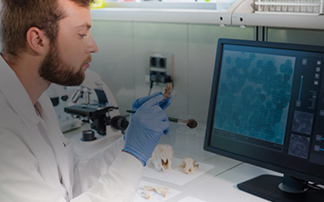-
A. Awadi, F. Suchentrunk, F. Knauer, S. Smith, Z. Tolesa, H. Ben Slimen (in press). Spatial diversity of MHC class II DRB exon2 sequences in North African cape hares (Lepus capensis): positive selection and climatic adaptation signals. Mammalian Biology
-
A. Awadi, H. Ben Slimen, H. Schaschl, F. Knauer, F. Suchentrunk (2021). Positive selection on two mitochondrial coding genes and adaptation signals in hares (genus Lepus) from China. BMC Ecology and Evolution 21:100.
-
A. Awadi, H. Ben Slimen, S. Smith, F. Knauer, Makni M., F. Suchentrunk (2018). Positive selection and climatic effects on MHC class II gene diversity in hares (Lepus capensis) from a steep ecological gradient. Scientific Reports 8(1):11514.
-
A. Awadi, H. Ben Slimen, S. Smith, J. Kahlen, M. Makni, F. Suchentrunk (2018). Genetic diversity of the toll-like receptor 2 (TLR2) in hare (Lepus capensis) populations from Tunisia. C R Biol. 341(6):315-324.
-
H. Ben Slimen, A. Awadi, Z. Gebremariam, F. Knauer, F. Suchentrunk (2018). Positive selection on the mitochondrial ATP synthase 6 and the NADH dehydrogenase 2 genes across 22 hare species (genus Lepus). Journal of Zoological Systematics and Evolutionary Research, 56(3): 428-433.
-
C. I. Gedeon, I. E. Hoffmann, O. Vaczi, F. Knauer, H. Ben Slimen, M. Stefanovic, E. Lehoczky, A. Laborczi, F. Suchentrunk (2017). The role of landscape history in determining allelic richness of European ground squirrels (Spermophilus citellus) in Central Europe. Hystrix, the Italian Journal of Mammalogy, 28(2):231–239.
-
Z. Tolesa, E. Bekele, K. Tesfaye, H. Ben Slimen, J. Valqui, A. Getahun, G. B. Hartl, F. Suchentrunk (2017). Mitochondrial and nuclear DNA reveals reticulate evolution in hares (Lepus spp., Lagomorpha, Mammalia) from Ethiopia. Plos One, 12(8): e0180137.
-
H. Ben Slimen, A. Awadi, M. Makni (2017a). Ambient temperature and host specialization driving mitogenome evolution on the fruit flies of the genus Bactrocera. Evolutionary Ecology Research, 18: 443-457.
-
H. Ben Slimen, H. Schaschl, F. Knauer, F. Suchentrunk (2017b). Selection on the mitochondrial ATP synthase 6 and the NADH dehydrogenase 2 genes in hares (Lepus capensis L., 1758) from a steep ecological gradient in North Africa. BMC Evolutionary Biology, 17(1): 46.
-
A. Awadi, F. Suchentrunk, M. Makni, H. Ben Slimen (2016). Variation of partial transferrin sequences and phylogenetic relationships among hares (Lepus capensis, Lagomorpha) from Tunisia. Genetica 144(5): 497-512.
-
G. Markov G, P. Zhelev, H. Ben Slimen, F. Suchentrunk (2016). Population genetic data pertinent to the conservation of Bulgarian chamois (Rupicapra rupicapra balcanica). Conservation Genetics (17), 1: 155-164.
-
M. Mezghani Khemakhem,W. Ben Lazahr, D. Bouktila, H. Ben Slimen, H. Makni, M. Makni (2013). A rapid diagnostic technique of Bactrocera cucurbitae and Bactrocera zonata (Diptera: Tephritidae) for quarantine application. Pest Management Science (69), 6: 744-746.
-
H. Schaschl, F. Suchentrunk, D. Morris, H. Ben Slimen, S. Smith, W. Arnold (2012). Sex-specific selection for MHC variability in Alpine chamois. BMC Evolutionary Biology, 12:21
-
H. Ben Slimen, C. Gedeon, I. Hoffmann, F. Suchentrunk (2012). Dwindling genetic diversity in European ground squirrels?. Mammalian Biology (77), 1: 13-21.
-
F. Zachos, H. Ben Slimen, K. Hacklander, M. Giacometti, F. Suchentrunk (2010). Regional genetic in situ differentiation despite phylogenetic heterogeneity in Alpine mountain hares. Journal of Zoology (282), 1: 47-53.
-
F. Suchentrunk, H. Ben Slimen, U. Kryger (2009). Molecular evidence of conspecificity of South African hares conventionally considered Lepus capensis L., 1758. Mammalian Biology (74), 5: 325-343.
-
H. Ben Slimen, F. Suchentrunk, C. Stamatis, Z. Mamuris, H. Sert, P. C. Alves, U. Kryger, A. B. Shahin, A. Ben Ammar Elgaaied (2008). Population genetics of cape and brown hares (Lepus capensis and L. europaeus): A test of Petter's hypothesis of conspecificity. Biochemical Systematics and Ecology (36), 1: 22-39.
-
H. Ben Slimen, F. Suchentrunk, A. Ben Ammar Elgaaied (2008). On shortcomings of using mtDNA sequence divergence for the systematics of hares (genus Lepus): An example from cape hares. Mammalian Biology (73), 1: 25-32.
-
F. Suchentrunk, H. Ben Slimen, M. Scandura, M. Appolonio (2007). Molecular genetic aspects of Lepus corsicanus. In: de Filippo G., De Riso L., Riga F., Trocchi V., Troisi S.R. (a cura di) 2007. Conservazione di Lepus corsicanus De Winton, 1898 e stato delle conoscenze. IGF Publ., Napoli, Italia: 23-35.
-
F. Suchentrunk, J.E.C. Flux, Mag M. Flux, H. Ben Slimen (2007). Multivariate discrimination between East African cape hares (Lepus capensis) and savanna hares (L. victoriae) based on occipital bone shape. Mammalian Biology, 72 (6): 372-383.
-
F. Suchentrunk, H. Ben Slimen, H. Sert (2007). Phylogenetic aspects of nuclear and mitochondrial gene pool characteristics of South and North African cape hares (Lepus capensis) and European brown hares (L. europaeus). In: P. C. Alves, N. Ferrand, K. Hackländer (eds) Biology of Lagomorphs: Systematics, Ecology and Conservation. Springer, Berlin: 65-85.
-
M. Scandura, L. Iacolina, H. Ben Slimen, F. Suchentrunk, M. Apollonio (2007). Mitochondrial CR-1 Variation in Sardinian Hares and Its Relationships with Other Old World Hares (Genus Lepus). Biochemical Genetics, 45: 305-323.
-
Suchentrunk F., H. Ben Slimen, Stamatis C., Sert H., Scandura M., Apollonio M., Mamuris Z (2006). Molecular approaches revealing prehistoric, historic, or recent translocations and introductions of hares (genus Lepus) by humans. Human Evolution, 21: 151-165.
-
H. Ben Slimen, F. Suchentrunk, A. B. Shahin, Amel Ben Ammar Elgaaied (2006). Phylogenetic analysis of mtCR-1 sequences of Tunisian and Egyptian hares (Lepus sp.or spp., Lagomorpha) with different coat colours. Mammalian Biology, 72(4): 224-239.
-
H. Ben Slimen, F. Suchentrunk, A. Memmi, H. Sert, U. Kruyger, P.C. Alves, A. Ben Ammar Elgaaied (2006). Evolutionary relationships among hares from North Africa (Lepus sp. or Lepus spp.), cape hares (L. capensis) from South Africa, and brown hares (L. europaeus), as inferred from mtDNA PCR-RFLP and allozyme data. Journal of Zoological systematics and Evolutionary Research, 44 (1): 88-99.
-
H. Ben Slimen, F. Suchentrunk, A. Memmi, A. Ben Ammar Elgaaied (2005). Biochemical genetic relationships among Tunisian hares (Lepus sp.), South African cape hares (L. capensis), and European brown hares (L. europaeus). Biochemical genetics, 43: 577-596.
-
H. Ben Slimen, H. Guerbej, A. Ben Othmen, I. Ould Brahim, H. Blel, N. Chatti, A. El Abed, K. Said (2004). Genetic differentiation between populations of gilthead seabream (Sparus aurata) along the Tunisian coast. Cybium, suppl., 28 (1): 45-60.
|














